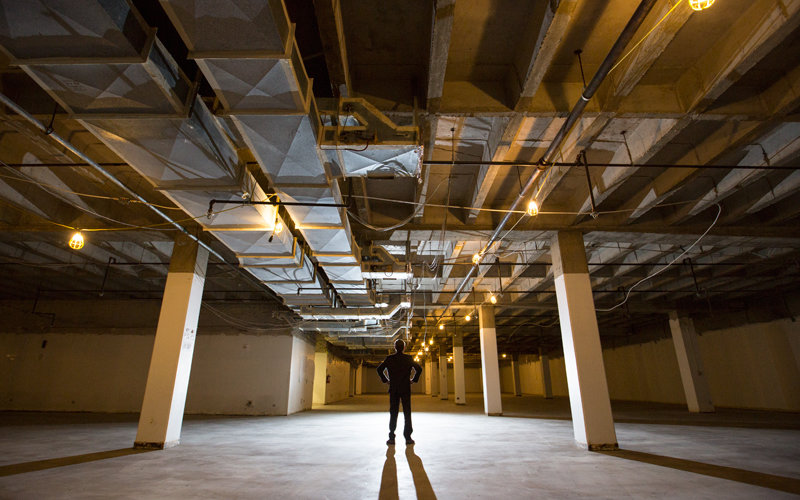
Interim University Librarian Scott Hewitt stood in the middle of an empty fourth floor in the Pollak Library marveling at what is to come.
“Right now it looks like a large empty parking structure,” Hewitt said. “But when this is completed, it will be a student-centered area with new technologies and spaces geared toward enhancing the learning experience and the future of our library services.”
Since September, the library has been undergoing the first phase of renovations to three floors of the south portion of the library. Construction crews have been working on abatement and demolition on the floors that sustained damage during a 2014 earthquake.
The Pollak Library renovation is a key element in the University’s Library of the Future project. A task force began a visioning process in 2013 based on goals from the CSU Libraries of the Future Task Force and feedback from the campus community. The systemwide initiative is aimed at leveraging technological advances and resource sharing to transform the CSU’s library services. The initiative includes renovating facilities and determining the best use of space.
Hewitt said the renovation scenario for Pollak Library includes making it a creative, intellectual, and cultural hub for students, as well as a one-stop shop for faculty teaching and technology needs.
In collaboration with IT, the Academic Technology Center, the Faculty Development Center, and Online Academic Strategies & Instructional Support, the library has completed a series of makeovers to various spaces since August 2014. Student Success Initiative funding was used to fund part of these renovations.
Hewitt said that the first phase is going well and cited some of the key elements:
- Renovation of the first, fourth and fifth floors of the south library with an anticipated completion date of the end of 2017.
- The first floor is aimed at being a student-centered area and will include the student resource centers: African American, Asian Pacific American, Chicana and Chicano Research Center, Graduate Student Success Center, Honors and Scholars, Titan Dreamers and LGBTQ, as well as Circulation, Titan Card and the Patrons Book Sale Center.
- Installing book stacks in the north basement where the Titan Computer Lab existed, decreasing the number of stacks on the first and fourth north floors, and increasing student seating throughout the library.
- Moving the Faculty Development Center and OASIS from the south basement to the second floor south and merging with the Academic Technology Center to form a one-stop shop for faculty.
- Moving more than 641,000 books from the south library to the north library – basement, second floor and third floor — so that the books can be browsed.
- Decreasing the density of first-floor computers — shifting computers to the fourth floor — and on the other floors adding 160 extra seats, more collaborative spaces, more electrical outlets, and new furniture and white boards.
- Converting the second floor bridge area into a faculty-student collaboration area.
Hewitt said that the second phase of renovation is expected to begin in 2018, depending on completion of the first phase and any unanticipated delays.
The CSU statewide initiative also includes a unified library management system, which is a cloud-based service platform that will deliver and manage library services and content with the aim of creating a single library management system across all 23 campuses.
Hewitt said that the single system replaces three to five systems used now on each campus and will allow for greater access to digital content from all of the CSU libraries.
The Pollak Library is preparing for the adoption of the unified system, which is scheduled to go live in the summer of 2017.
Interim Associate University Librarian Anthony Davis said: “With the unified library management system, we’ll be able to reduce effort across the 23 campus system by collectively sharing records, standards and resources. Yet the platform has the flexibility to allow each campus to customize its instance to the needs of its students and campus community.”